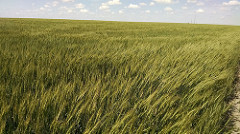Released: May 9, 2017
New wheat appears well suited for dryland farms in western Kansas
Tatanka seed will be available for 2017 planting

HAYS, Kan. – One might say its pedigree includes royalty – a new hard red winter wheat variety that will be available for growers to plant for the fall 2017 season.
Through several years of testing, Tatanka performed well across Kansas, particularly in dryland fields in western Kansas. The new variety was developed by Hays-based Kansas State University wheat breeder Guorong Zhang.
Wheat breeding is not for the impatient. The new variety took nine years to develop, Zhang said.
The lineage of Tatanka’s one parent (a hard white breeding line) includes Jagger, a hard red winter wheat which for many years was a favorite of Kansas growers, and Trego, a hard white wheat developed by the K-State wheat breeding program in Hays. Tatanka’s other parent is T151, a hard red winter wheat developed by Trio Research Inc. Through cross-breeding, the goal was to develop a variety that incorporated some of the best traits from each.
“Farmers will like its high yield, good drought tolerance, winter-hardiness and its good resistance to stripe rust and soil-borne mosaic virus,” Zhang said. It has above-average test weight and good milling and baking quality.
This new variety has high yield potential, Zhang said. It could yield 100 bushels per acre or more under the right conditions. The new wheat’s straw is not particularly strong, so too much grain yield could cause some lodging. Therefore, it is not suitable for irrigation production.
The new wheat variety honors another species that at one time thrived on the U.S. High Plains – the name Tatanka comes from the Lakota Indian word for buffalo, also known as American bison.
Two other new hard red winter wheat varieties developed by K-State are Larry and Zenda. The latter is better suited for central and eastern Kansas while the former is broadly adapted for planting across much of the state. Larry is named after a longtime member of the K-State wheat breeding team, Larry Patton, and Zenda is named for a town of that name in Kingman County, Kansas.
More information about Tatanka is available in a new K-State publication online at http://www.bookstore.ksre.ksu.edu/pubs/L939.pdf or at county and district K-State Research and Extension offices across the state.
-30-
K‑State Research and Extension is a short name for the Kansas State University Agricultural Experiment Station and Cooperative Extension Service, a program designed to generate and distribute useful knowledge for the well‑being of Kansans. Supported by county, state, federal and private funds, the program has county Extension offices, experiment fields, area Extension offices and regional research centers statewide. Its headquarters is on the K‑State campus in Manhattan.
Story by:
Mary Lou Peter
mlpeter@ksu.edu
K-State Research and Extension
http://www.ksre.ksu.edu
For more information:
Guorong Zhang – gzhang@ksu.edu
